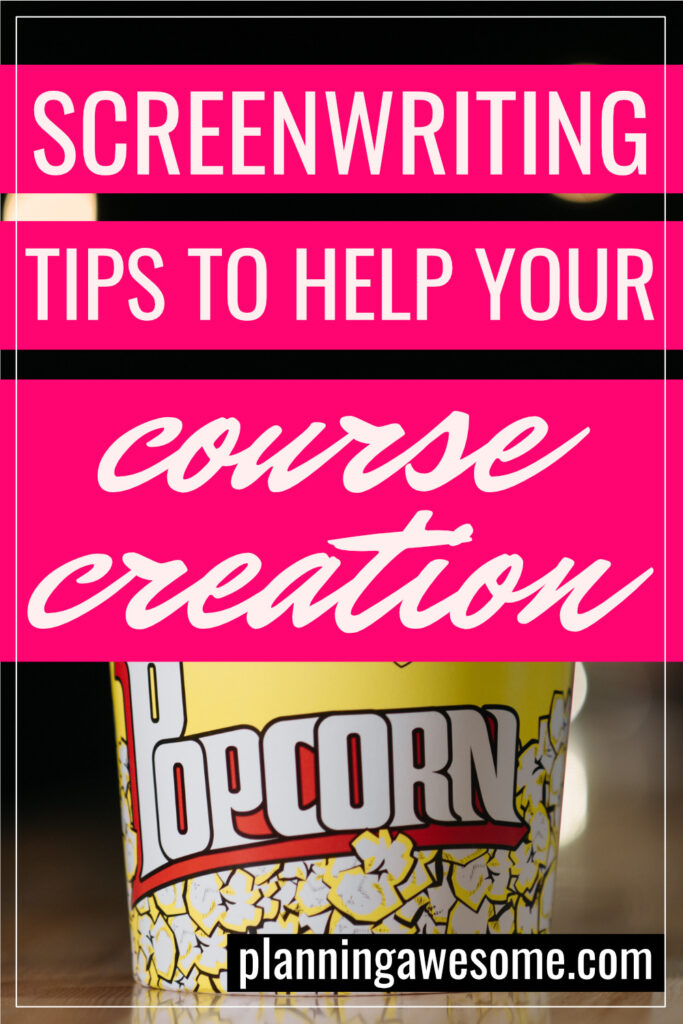Screenwriting Tips to Help Your Course Creation

Do you worry that you will spend weeks, perhaps months or even years creating a course and people will find it…boring? The worst reaction your audience could have to your videos or course content would be the yawning and eye rubbing we all do when trying to stay awake, right? How could anyone not enjoy the topic you’ve been so passionate about for so long? Well, to try to prevent this from happening, let’s talk about one way we can create an engaging course and keep those folks awake!
I wrote a screenplay a few years back.
I had a movie in my head for a number of years, and I decided to learn the craft of screenwriting and get it all out on paper. I didn’t just Google “how to write a screenplay” because I knew that would lead me to a lot of interesting sites teaching me what to do, but I was sure the writers of a number of the really bad movies I’d seen also looked at those same sites. Instead, I invested in a screenwriting course and got help from a very talented creative director from a “major movie studio.”
Between you and me, I know this guy hated my screenplay. Have you ever been in a class where it seems like everyone else is getting attention and helpful feedback, except you? Yeah, that was me with this guy. But I kept going until I finished…and 110 pages later, it’s still sitting on my hard drive waiting for whatever it’s second Act will entail…
I learned quite a few lessons about how to take the movie in my head and transform it into words for actors and directors to read. One thing that really stuck with me was to keep in mind that a movie is limited in time (about 90 minutes on average) and everything you need to say must be said in that 90 minutes (about 90-120 pages). In order to do this, you have to be very efficient in the way you write – meaning dump a lot of unnecessary dialog and explanations and make sure everything moves the story forward.
What Does This Have to Do With Courses?
As I work with others to create courses in the form of eLearning modules, videos, games and other types of learning, I see that the techniques needed to tell a story visually for a movie are the same for these media formats. Because courses can be a very visual products, you really need to make sure you build “scenes” properly – and because of the costs in time, resources and cash, you have to build them efficiently.
Screenwriting Tips to Create an Engaging Course
Here are five tips I’d like to offer when designing courses taken from what I’ve learned about writing a screenplay. Think of it like you would a movie:
1. Keep Moving
Everything you write must move the story forward. Eliminate anything that doesn’t move the story forward. Keep the pace interesting.
2. Think Visually
Think visually instead of with words. Rely on action to tell the story, not on dialog. Remember that you will have pictures and videos that help to tell the story.
3. Set a Goal
Give the main character a goal and a timeframe to reach it. Put obstacles in his way so that he can’t easily reach his goal.
4. Get In Late, Get Out Early
Don’t add in too much introduction and don’t add in too much conclusion. In many stories you want to introduce “normal life” and how that normal life is disrupted. Avoid putting in too much “normal life” before getting to the plot of the story.
5. Keep It Simple
Adding more and more characters and sub-plots that don’t move the story forward will make a confusing story. Does Billy really need to walk down to the river with 8 friends, all of whom have a speaking parts with different opinions in the story? Or can Billy simply go with his best friend who is his total opposite to the river?
In the tips above, perhaps the “character” is your learner – or maybe it’s a topic or additional information you want to include. “Normal life” could be the learner’s current situation or knowledge about the topic – how can your training disrupt that current situation? Perhaps convoluted sub-plots could just mean you pose fewer questions to the learner in knowledge checks or quizzes. Think about how a movie can be an analogy for your course. Screenwriting techniques can always be weaved into any videos you create for your course.
I know it all sounds confusing because we’re told we need an outline of the course and then to flesh out our points and build lessons. That’s just how I do it, I always start with an outline. But what I’m suggesting is thinking outside of the box (outside of the out…lines?) and trying to approach building your course differently – through a story that has a beginning, a little excitement in the middle and a strong conclusion.
Can you condense your content so that it fits within 90 minutes? What would you keep? What content would end up on the cutting room floor? If you have bland content, how can you teach it visually? What are some ups and downs you can take your learner on through your course? Would you course be an action movie, comedy…or horror?




